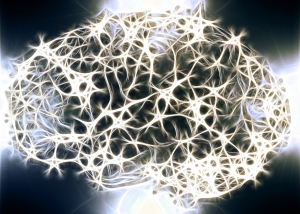AIC2017LA: Six types of Alzheimer's disease and how to identify them
June 1, 2017
 Most people in the U.S. are affected by Alzheimer’s disease (AD)—they either have it themselves, or know someone who is, said Dale Bredesen, MD, an internationally recognized as an expert in the mechanisms of neurodegenerative diseases, who spoke at the Institute for Functional Medicine’s 2017 Annual International Conference in Los Angeles, California earlier today. The general assumption is that there is no way to prevent or reverse Alzheimer’s. While there may not be a cure for the disease, Bredesen is spearheading efforts that help reverse cognitive decline in AD patients, based on the idea that a lack of nutrients impair cognition. Part of his efforts include identifying subtypes of the disease to target treatment efforts. Several different metabolic syndromes are called "Alzheimer’s disease," which can be broken down into six subtypes:
Most people in the U.S. are affected by Alzheimer’s disease (AD)—they either have it themselves, or know someone who is, said Dale Bredesen, MD, an internationally recognized as an expert in the mechanisms of neurodegenerative diseases, who spoke at the Institute for Functional Medicine’s 2017 Annual International Conference in Los Angeles, California earlier today. The general assumption is that there is no way to prevent or reverse Alzheimer’s. While there may not be a cure for the disease, Bredesen is spearheading efforts that help reverse cognitive decline in AD patients, based on the idea that a lack of nutrients impair cognition. Part of his efforts include identifying subtypes of the disease to target treatment efforts. Several different metabolic syndromes are called "Alzheimer’s disease," which can be broken down into six subtypes: - Type 1: Inflammatory (“Hot”)
- Type 2: Atrophic (“Cold”)
- Type 1.5: Glycotoxic (“Sweet")
- Type 3: Toxic (“Vile”)
- Type 4: Vascular (“Pale”)
- Type 5: Traumatic (“Dazed”)
Type 1: Inflammatory (“Hot”)
Characteristics of this AD subtype include:- Inflammatory (Ayurvedic pitta)
- Increase in hs-CRP and/or other inflammatory markers (e.g., increases in IL-6, IL-8, TNFα, etc.)
- Reduction in A/G ratio
- Increase in M1/M2 ratio; reduction in MFI
- ApoE4 is important risk factor
- Presentation is typically amnestic
- Hippocampal atrophy is common
- Seek cause(s) of inflammation (e.g., gut leak, AGEs, diet,poor oral hygiene, etc.)
- ApoE3/4, amyloid PET is markedly positive, FDG-PET typical for AD, hippocampal volume reduced, neuropsych testing MCI
- Hs-CRP 9.9
- Homocysteine 15.1
- Vitamin D 21
- Testosterone 264, free T3 2.4, TSH 2.21
Type 2: Atrophic (“Cold”)
Characteristics of this AD subtype include:- Atrophic (“cold;” Ayurvedic vata)Patients tend to be older than type 1Typically amnestic presentation; patients often protest that nothing is wrongReductions in trophic support (e.g., estradiol, progesterone, testosterone, vitamin D, pregnenolone, thyroid, NGF, BDNF)
- ApoE4 is risk factor
- Rapid reductions in support are most concerning (cf.oophorectomy at <41 without HRT), c/w depR mismatch
- Hippocampal atrophy is common
- Optimizing support may be complicated by receptor response, HRT controversy, trophic factor delivery (intranasal vs. peptides vs. indirect, etc.)
- ApoE3/3
- FDG-PET c/w Alzheimer’s. MRI with HC volume 16th percentile
- On-line cognitive assessment 9th percentile for age
- Low vit D, pregnenolone, progesterone, estradiol, fT3, B12
- Diagnosis of mild cognitive impairment (MCI)
Type 1.5: Glycotoxic (“Sweet”)—Combines 1 and 2
Characteristics of this AD subtype include:- Glycotoxic (“sweet”)
- Inflammatory part from AGEs (via RAGE, glyoxals, etc.)and related
- Atrophic part from insulin resistance (e.g., IRS1 S/Tphos.)
- Goetzl noted insulin resistance in 100% of the neuralexosomes from AD patients (measured via IRS1).
- ApoE4 is an important risk factor
- Amnestic presentation is common
- Hippocampal atrophy is common
- Paradox of insulin sensitization and trophic requirement
- Fasting insulin 14, hemoglobin A1c 5.8, fbs 102
- hs-CRP 0.1
- ApoE3/3
- BMI 33
- Normal Cu:Zn, Mg, vit D, Hg, hormones
Type 3: Toxic (“Vile”)—A fundamentally different problem
Characteristics of this AD subtype include:- Age at symptom onset < 65
- ApoE4-negative (often)
- Negative family history (or only older)
- Low triglycerides and/or zinc
- HPA dysfunction
- Depression
- Problems with math or organization or word finding
- Exposure to toxins (mercury, mycotoxins, CIRS-related such as Lyme, MARCoNS, surgical implants, chronic viral infections)
- Precipitation or exacerbation by stress.
- “Atypical Alzheimer’s,” often with frontal effects and imaging.
- High C4a (>2800), TGF-beta-1 (>2380); low MSH (<35)
- HLA-DR/DQ with “dreaded” multiple biotoxin sensitive orpathogen-specific (4-3-53, 11-3-52B, 12-3-52B, 14-5-52B)
- MARCoNS (multiple-antibiotic resistant coagulase-negativeStaphylococcus, deep nasopharyngeal culture)—biofilmassessment
- Visual contrast sensitivity abnormalities
- Surprisingly, most do NOT have allergic symptoms
- Most do not fulfill criteria for CIRS, yet have laboratory valuescompatible with CIRS—thus “ISIS” (innate system immunestimulation)
- Potential relationship to Lewy body disease
- Most difficult type of AD to treat successfully
- FDG-PET: temporal and parietal > frontal reduced glucose utilization, compatible with Alzheimer’s disease.
- Seen at university dementia center, started on antidepressant and donepezil
- ApoE3/3, negative family history, hs-CRP 0.2, C4a 5547, TGF-α1 7037, VCS failed, anti-Lyme negative, anti-thyroglobulin antibodies 1:2000.




















SHARE